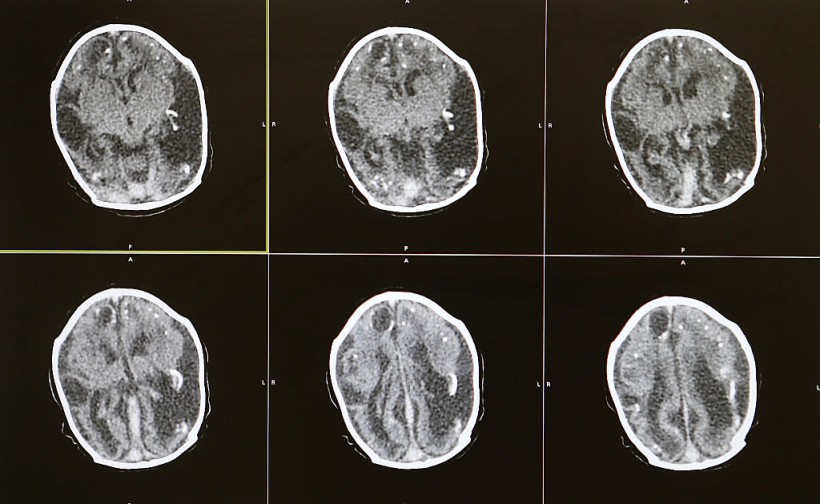A study conducted by UNC-Chapel Hill's Mark Shen, PhD, Heather Hazlett, PhD, and Joseph Piven, MD, is the first to indicate amygdala enlargement in the first year of life.
Before kids display most of the behavioral characteristics that ultimately lead to a diagnosis of autism, newborns with fragile X condition have a distinct neural maturation trajectory, this proliferation might have been distinctive to autism.
Babies' Brain Growth Linked To Autism

RECIFE, BRAZIL - JANUARY 27: Brain scans of a 2-month-old baby with microcephaly are displayed by Dr. Vanessa Van Der Linden, the neuro-pediatrician who first recognized and alerted authorities of the microcephaly crisis in Brazil, on January 27, 2016 in Recife, Brazil.
According to news article published by SciTechDaily, the amygdala is a tiny region buried within the cortex that is vital for understanding the sociological as well as psychological significance of perceptual information. Previously, the amygdala was assumed to have a significant part in the behavioral problems that are essential to autism.
The above experiment, published in The American Journal of Psychiatry, the accredited journal of the American Psychiatric Association, found that newborn babies with fragile X pathology have developmental impairments at six months of age, whilst the newborn babies with autism do not have any impairments in intellectual capabilities at six months of age, but have a progressive downward trend in intellectual competency respectively to six and 24 months of age, the maturity level as they were detected with Autism Spectrum Disorder, as per LiveScience.
The investigators included 408 children in altogether, encompassing 58 newborns at greater risk of acquiring autism who have been subsequently identified with autism, 212 newborns at heightened risk of obtaining autism who did not display autism, 109 generally functioning counterparts, and 29 newborns with fragile X disorder.
Previous research by the IBIS crew and collaborators has demonstrated that, while the communicative impairments that characterize autism are not apparent at six months of age, newborns who go to acquire autism have issues by how they respond to optical cues in their environment as neonates.
Their amygdala, on the other hand, grows quicker than other newborns (many with fragile X syndrome and those that do not acquire autism) between ages of six and twelve months, and is greatly expanded by the age of twelve months.
The heightened amygdala maturation in newborns subsequently confirmed with autism varied significantly from brain-growing tendencies in neonates with some other neurodegenerative condition, fragile X condition, where no abnormalities in amygdala expansion were identified.
Also read: Missing Body of Montana Man Found After an Attack from a Grizzly Bear, Officials Say
Newborns with Autism and Overgrowth in Brain Structure
Furthermore, the said exploration, is the initial one to show amygdala abnormal accumulation prior to actually autism symptoms appear, was carried out by The Infant Brain Imaging Study (IBIS) Connectivity, a collaboration of ten educational institutions in the United States as well as Canada supported by a National Institutes of Health Autism Center of Excellence Network award.
Amygdala enlargement was thus associated to extreme distress in investigation of various mental illnesses (e.g., anxiety and depression), might give a hint to explaining this phenomenon in children who acquire autism later down the line.
Overgrowth develops in between ages of six and twelve months, up until the age at which the characteristic symptoms of autism completely manifest, allowing for the best early detection of this illness.
This amygdala growth persists until the child is 24 months old, at which point his or her abnormalities are frequently severe enough to establish an early detection of autism.
And according to the experts working on the study, the quicker the amygdala expanded in early life, the more behavioral impairments the kid displayed a year afterwards when classified with autism.
As parents and caregivers of children with autism, it's important to stay informed on the latest research and treatment options. One such option is Applied Behavior Analysis Principles, which have been shown to be effective in improving social and behavioral skills in children with autism. For more information on ABA principles, please visit Autism Parenting Magazine.
Related article: New Kind of Ultraviolet Light could Help Us Combat the Transmission of Airborne Pathogens
© 2024 NatureWorldNews.com All rights reserved. Do not reproduce without permission.
* This is a contributed article and this content does not necessarily represent the views of natureworldnews.com





